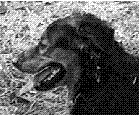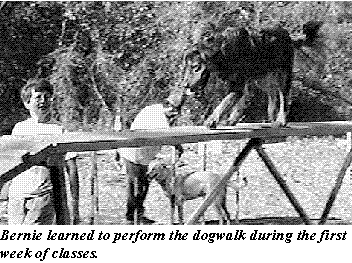ARF! Newsletter, Winter 1995-96

Bernie, The Mixed Breed That Became a Purebred
In one of our beginning agility classes this fall, we had two dogs that
looked nearly identical, Bernie and Cassidy. I saw the owners talking
with each other fairly regularly, and I thought that they knew each other.
Perhaps these two dogs were from the same litter. But Bernie's class
registration listed him as a one-year-old mixed breed and Cassidy was
listed as a 10-month-old English Shepherd.
I had never heard of an English Shepherd, so I decided to look in some reference books. First I
went to the American Kennel Club's "The Complete Dog Book." The index includes English
Cocker Spaniel, English Foxhound, English Setter, English Springer Spaniel, English Toy
Spaniel, and of course, the Old English Sheepdog - no English Shepherds.
There are plenty of purebred dog breeds that are not recognized by the AKC, so next I pulled out
"Simon and Schuster's Guide to Dogs." This book rarely fails to have information on a purebred
dogs that are not in the AKC book. Breeds like the Rough-coated Bohemian Pointer, the
Xoloitzcuintle, the Billy, the Transylvanian Hound, and even a Swedish Shepherd are described.
But not an English Shepherd.
 At this point I started to think that
Cassidy's owner was just putting me
on. I had a friend who claimed his
mixed-breed was a very rare purebreed
- a Peruvian Herder. He didn't fool
many people. But English Shepherd is
an ingeniously subtle, believable name
for a breed of dog.
At this point I started to think that
Cassidy's owner was just putting me
on. I had a friend who claimed his
mixed-breed was a very rare purebreed
- a Peruvian Herder. He didn't fool
many people. But English Shepherd is
an ingeniously subtle, believable name
for a breed of dog.
Later that week I was looking for some
information about coondogs to
supplement the 1995 Coondog Trials
article in this newsletter. As I was
going through some United Kennel
Club magazines, a familiar dog
suddenly appeared. It looked just like
Bernie and Cassidy. It was doing agility. It was an English Shepherd. There was also an address
for the English Shepherd Association.
It turns out that Bernie and Cassidy had never met before, and that the reason I had been seeing
the owners together at class was because they were comparing their very similar dogs. Bernie's
owner now thinks he's probably a purebred English Shepherd, now that she's met Cassidy and
has seen the UKC magazine article.
Cassidy's owners did a lot of research before selecting an English Shepherd as the right breed of
dog for their family. Cynda, Bernie's owner, did a different kind of research before finding her
"mixed breed." She had given a friend at the Fayette County Humane Society a list of qualities
to look for in a shelter dog and to let her know when the right dog showed up. Soon she got the
call, but not for Bernie. When Cynda showed up to look at the other dog, she found and adopted
Bernie, whose previous owner had listed as a mixed breed.
Later that week I was looking for some information about coondogs to supplement the 1995
Coondog Trials article in this newsletter. As I was going through some United Kennel Club
magazines, a familiar dog suddenly appeared. It looked just like Bernie and Cassidy. It was
doing agility. It was an English Shepherd. There was also an address for the English Shepherd
Association.
It turns out that Bernie and Cassidy had never met before, and that the reason I had been seeing
the owners together at class was because they were comparing their very similar dogs. Bernie's
owner now thinks he's probably a purebred English Shepherd, now that she's met Cassidy and
has seen the UKC magazine article.
Cassidy's owners, the Landers, did a lot of research before selecting an English Shepherd as the
right breed of dog for their family. Cynda Byers, Bernie's owner, did a different kind of research
before finding her "mixed breed." She had given a friend at the Fayette County Humane Society
a list of qualities to look for in a shelter dog and to let her know when the right dog showed up.
Soon she got the call, but not for Bernie. When Cynda showed up to look at the other dog, she
found and adopted Bernie, whose previous owner had listed as a mixed breed.
 At this point I started to think that
Cassidy's owner was just putting me
on. I had a friend who claimed his
mixed-breed was a very rare purebreed
- a Peruvian Herder. He didn't fool
many people. But English Shepherd is
an ingeniously subtle, believable name
for a breed of dog.
At this point I started to think that
Cassidy's owner was just putting me
on. I had a friend who claimed his
mixed-breed was a very rare purebreed
- a Peruvian Herder. He didn't fool
many people. But English Shepherd is
an ingeniously subtle, believable name
for a breed of dog.
